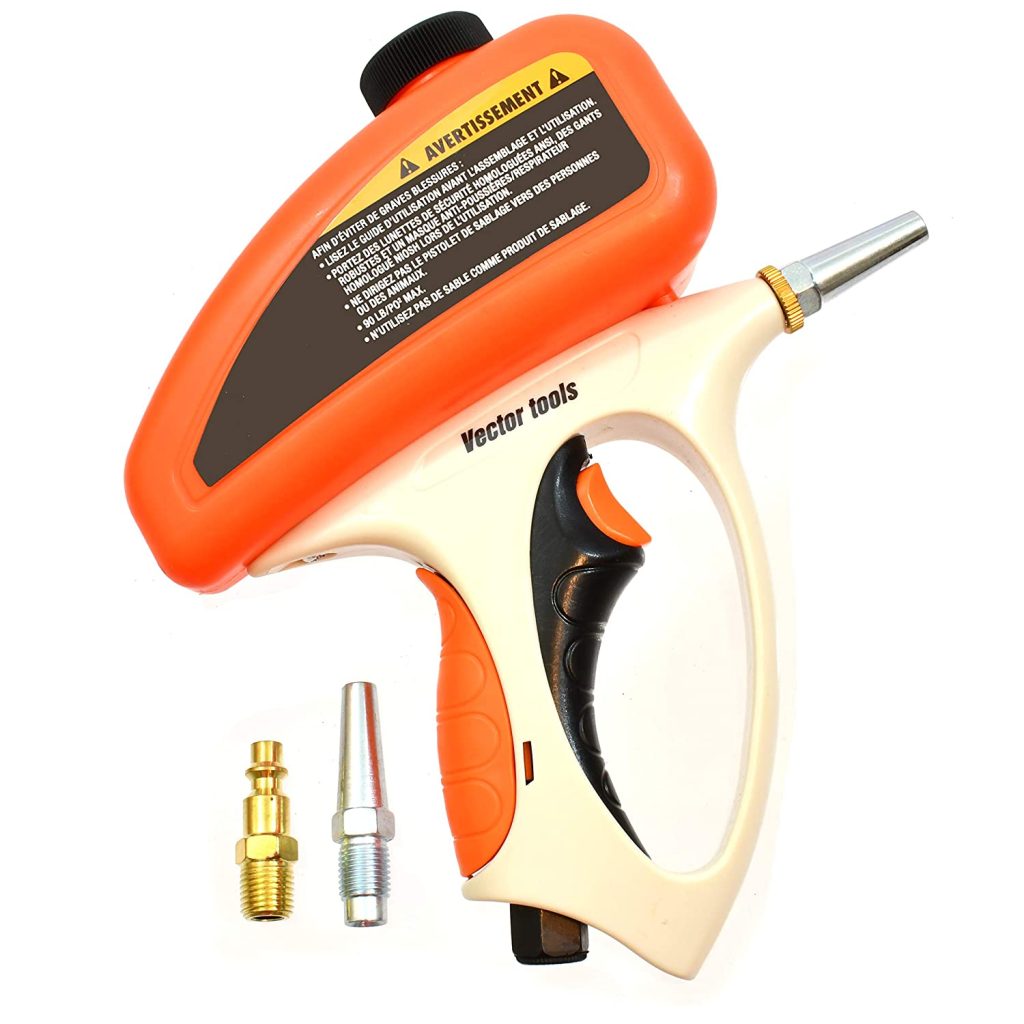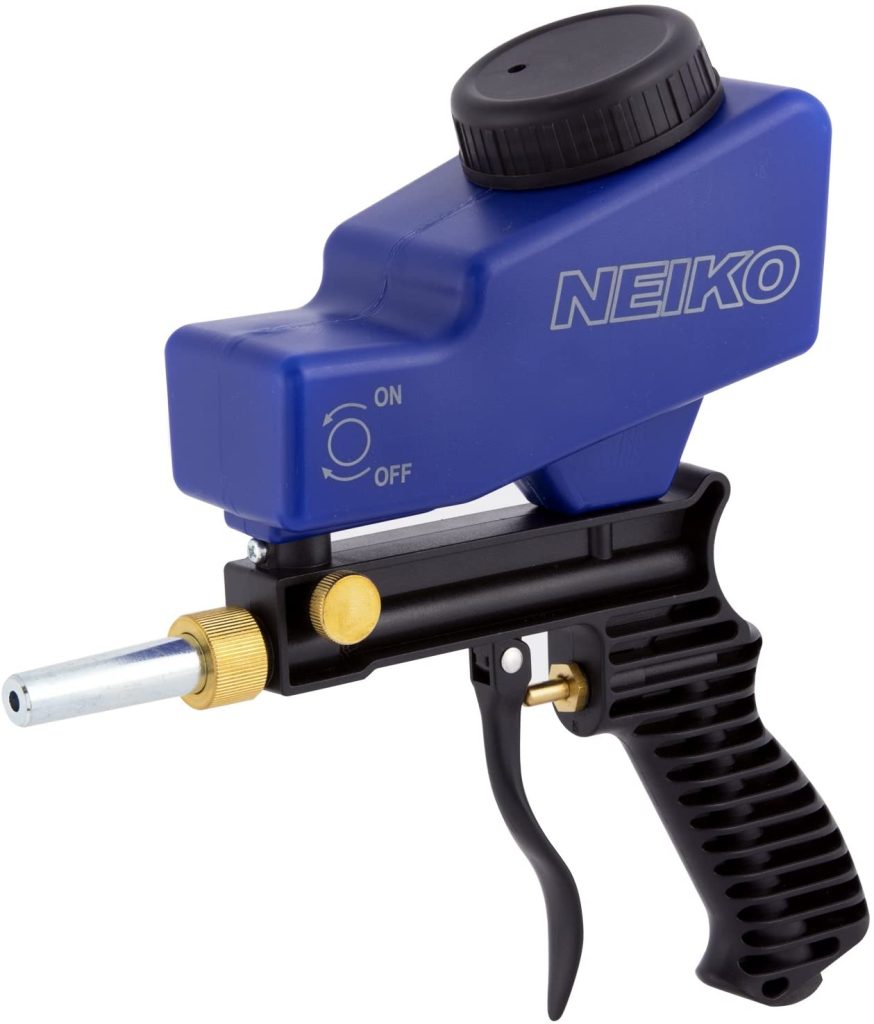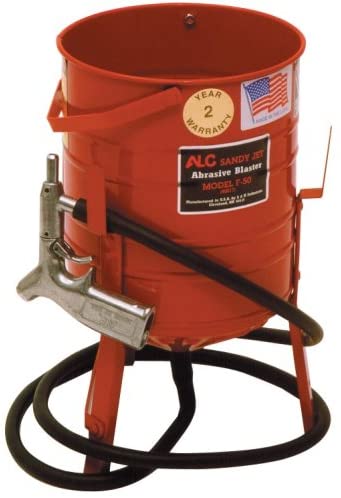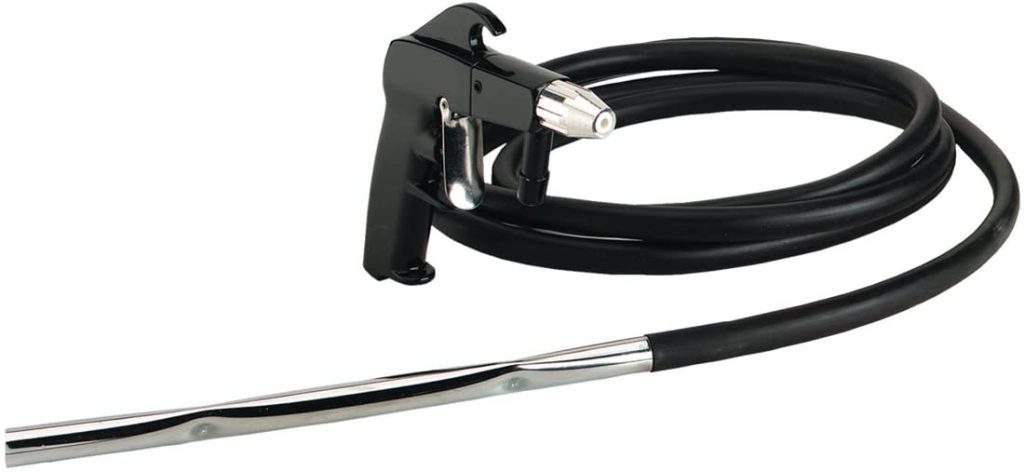Ever wondered how a sandblaster works? It’s a pretty fascinating process. In this comprehensive guide, we will take you through the entire process of how a sandblaster works, from start to finish. We’ll also discuss the different parts of the sandblaster and what each one does.
We will also discuss the various types of sandblasters on the market and how to choose the right one for your needs. So, if you’re curious about how these sandblasters work, read on!
What Is A Sandblaster?

A sandblaster is a powerful tool that uses compressed air to blast abrasive material, such as sand, at high speeds. The force of the blast cleans or shapes surfaces by stripping away old paint or rust or removing stubborn dirt and grime.
A sandblaster is an essential tool for those who work with blasting agents. It can be used to blast either wet or dry surfaces, depending on your needs and preferences.
Every sandblaster consists of:
- Air compressor
- Accumulative receiver
- Sandblasting Gun
- Containers with abrasive particles
- Automation and control systems
- Connecting hoses
How Does A Sandblaster Work?
The process of sandblasting is a time-honored technique that has been used for centuries. The method varies depending on what type you choose to use, but all guns have one thing in common: they are pressured at high pressures so as not only to blast away any material blocking your way forward but also remove it completely without residue or divots left behind!
A sandblaster uses compressed air to push abrasive particles through a nozzle at high velocity. The abrasive particles etch or remove the top layer of the material being blasted, while the compressed air provides a powerful stream to clear away debris.
- The first thing you need before using a sandblaster is an air compressor. The air compressor takes in atmospheric air and pressurizes it to create compressed air. This process is essential to the operation of the sandblaster.
- Next, you need to choose your abrasive material. Many different types of blasting media can be used depending on the job at hand. Common materials include sand, glass beads, aluminum oxide, and steel shot.
- Once you have your air compressor and abrasive material, you are ready to start blasting! Simply pour your chosen abrasive into the hopper of the gun, point it at the surface you wish to blast, and pull the trigger.
- The compressed air will push the abrasive particles through the nozzle of the gun and onto the surface you are blasting. The high velocity of the particles will remove the top layer of material, leaving a clean, smooth surface.
Related video: How A Blast Machine Works
Gravity Feed Sandblaster

There are many different types of sandblasters, but the gravity feed sandblaster is one of the most popular. This type of sandblaster uses gravity to force the abrasive material through the nozzle and onto the surface being cleaned.
Gravity feed sandblasters are very efficient and can be used on a variety of surfaces. They are often used to remove rust, paint, and other debris from metal surfaces. Gravity feed sandblasters are also great for cleaning glass and ceramic surfaces.
It contains the following parts:
1. Nozzle
The nozzle is the most important part of the gravity feed sandblaster. The nozzle controls the flow of abrasive material and determines the size and shape of the blast pattern.
2. Grit
Grit is the term used to describe the size of abrasive particles. The larger the grit, the more coarse the abrasive material will be.
The type of surface being cleaned will determine the appropriate grit size. A softer surface, such as wood or plastic, will require a finer grit than a harder surface, such as metal.
3. Air Compressor
An air compressor is required to operate a gravity feed sandblaster. The air compressor provides the force needed to propel the abrasive material through the nozzle.
Most air compressors have a tank that stores compressed air. The size of the tank will determine how long the sandblaster can be used before the air needs to be refilled.
4. Safety Equipment
When using a gravity feed sandblaster, it is important to wear the proper safety equipment. This includes a respirator to protect your lungs from the abrasive material, and eye protection to prevent the material from getting in your eyes.
5. Hose
The hose connects the sandblaster to the air compressor. The diameter of the hose will determine the amount of air that can be used at one time.
A larger diameter hose will allow more air to flow, which means more abrasive material can be used. A smaller diameter hose will limit the amount of air that can flow, which will limit the amount of abrasive material that can be used.
How Does Gravity Feed Sandblaster Work?
Gravity feed sandblasters are typically used for tasks such as removing paint from a car body or stripping rust off of metal surfaces. They can also be used to etch designs into glass or stone.
To understand how the gravity-fed blaster works, you need to know that there’s a tank of sand and an air pipe connected to it. When someone pulls the trigger on their gun, two things happen:
- First off compressed gas from blasters travels through the hose into the weapon.
- The second thing which creates an opening up at the bottom where all this goes happens because of gravitational force pulling particles towards the earth’s surface!
This causes the sand to be forced out of the tank, and as it does so air also rushes in through holes to create a stream.
Pressure Sandblaster

A pressure sandblaster is a powerful tool that can remove paint, rust, and other debris from surfaces. The high-pressure stream of sand particles can strip away stubborn grime quickly and easily.
Pressure sandblasters are available in a variety of sizes and styles to suit any need. Whether you’re looking to clean up a small area or blast away years of built-up grime, a pressure sandblaster can get the job done quickly and efficiently.
There are three main parts to a pressure sandblaster: the air compressor, the blast hose, and the nozzle.
- The air compressor provides the power to run the sandblaster.
- The blast hose carries the sand from the blaster to the nozzle.
- The nozzle is what controls the flow of sand and directs it at whatever surface you’re trying to clean.
How Does Pressure Sandblaster Work?
To use a pressure sandblaster
- Simply attach the blast hose to the air compressor and turn it on.
- Then, hold the nozzle close to the surface you want to clean and pull the trigger.
- The high-pressure stream of sand will remove any paint, rust, or debris quickly and easily.
- When you’re finished, simply release the trigger and turn off the compressor.
Pressure sandblasters are a powerful tool that can make quick work of cleaning up any surface. With just a few simple steps, you can strip away years of built-up grime in no time. So whether you’re looking to clean up a small area or blast away years of
Siphon Sandblaster

Siphon sandblaster is a device that uses a high-pressure stream of sand or other abrasive material to remove paint, rust, and other deposits from metal surfaces. It is one of the most versatile tools in the home shop and can be used for a variety of tasks such as cleaning engine parts, removing rust from tools, and even etching glass.
How Does Siphon Sandblaster Work?
The way to make your house look like it was never lived in is with this fantastic machine! You’ll need three things:
- A sandblasting gun, which you attach two hoses from (one going down into its handle and another connecting below).
- An air compressor or tank for holding pressurized gas that feeds through one hose onto itself at ground level when not being used as weaponized power tool consumption by efficient all-purpose household appliance
- Finally, some kind of container is big enough so nothing gets lost during operation.
Process
- First, set up your bucket below the sandblasting gun at ground level.
- Next, take the hose from the bottom of the gun and put it into the bucket. Make sure it’s a snug fit!
- Now, turn on your air compressor or tank and point the gun up in the air. You should see sand shooting out of the bottom of the gun into the hose and then into the bucket. Keep pointing it up until the Bucket is full, then turn off your air compressor or tank.
- Now, take the hose off of the bottom of the gun and put it into your container. You can now move the gun around and aim it at whatever you want to sandblast!
- When you’re finished, just turn off the air compressor or tank, and you’re done.
Safety Precautions
They are also very easy to use and can be used on a variety of different materials. However, there are a few things to keep in mind when using a sandblaster:
- Always wear eye protection when using a sandblaster, as the abrasive material can be very harmful to your eyes.
- Always use a dust mask when using a sandblaster, as the high-pressure stream of air can kick up a lot of dust and particles.
- Be careful not to aim the stream of abrasive material directly at yourself or anyone else, as it can cause serious injury.
- Be careful not to overdo it when using a sandblaster, as the abrasive material can quickly remove paint or other finishes from surfaces.
- If you are unsure of how to use a sandblaster, always consult with someone who is experienced in its use.
How Fast Does Sand Come Out Of A Sandblaster?
The speed of the sandblasting media depends on the pressure of the air being used to push it through the nozzle.
- A standard home compressor typically produces around 100 psi, which is enough to propel most types of media at a high velocity. The higher the pressure, the faster the media will travel.
- Industrial-grade sandblasters can produce up to 3000 psi, which is enough to break through thick layers of paint and rust.
So, if you’re looking to remove a heavy coating quickly, you’ll need a machine that can produce high pressure. For smaller jobs, though, a home compressor will likely suffice. Just be sure to use the proper type of media for your project. Some media, like aluminum oxide, can be harmful to bare metal surfaces.
Final Thoughts
Now that you know how a sandblaster works, you can decide if this is the right tool for your needs. Sandblasters are great for a variety of applications, from removing paint to preparing surfaces for welding. If you need a powerful tool to get the job done quickly and efficiently, a sandblaster is a way to go.
References
- https://blog.swantonweld.com/different-types-of-sand-blasting
- https://garage.eastwood.com/eastwood-chatter/10-applications-of-sandblasting-what-do-you-use-a-sandblaster-for/

Techno Commercial Manager – Professional Engineer
Having 10 years of on-field experience across various industrial sectors including refineries, power plants, sugar, food & beverage, distilleries and textiles sector, I am sharing my knowledge to help young engineers get a kick start in their fields.